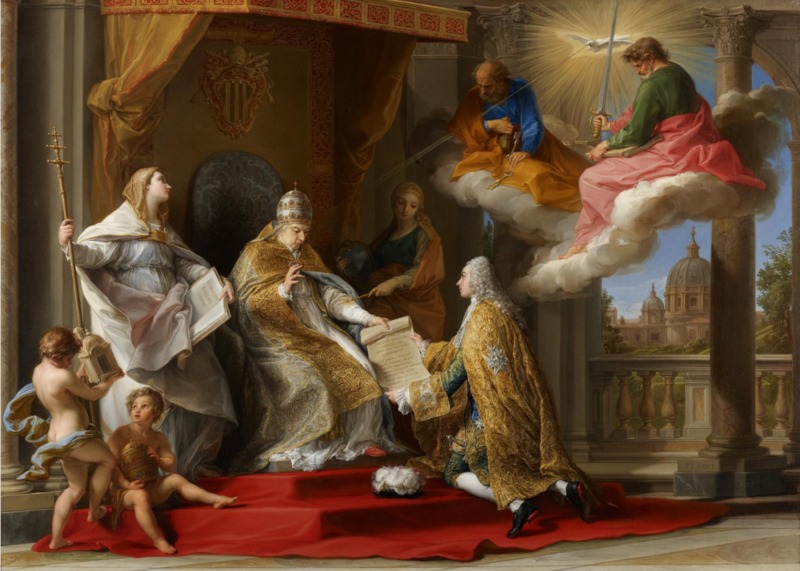Religious and Political Context of 18th Century Rome

Pompeo Girolamo Batoni, Pope Benedict XIV Presenting the Encyclical "Ex Omnibus" to the Comte de Stainville, Later Duc de Choiseul, 1757, oil on canvas (Minneapolis Institute of Art, Minneapolis)
During the 18th-century, Rome was ruled politically and socially by a clerical gerontocracy, led by a pope whose right to rule came from Jesus’s original gift of the Keys of Heaven to the first pope, Saint Peter. Often corrupt and deceptive, the ruling class suffered from constant scandals and naive decisions made by inexperienced rulers. Aware of the decline of their political influence and the constant attacks against their divine right to rule from more ‘rational’ Enlightenment discourse, the popes turned to promoting aspects of Roman culture and acting as a patron to the arts in order to gain approval, effectively cementing Rome’s position as the entrepôt of Europe during the Grand Tour.
Starting in 1700 with Pope Clement XI (1649-1721), who heavily promoted the growth of Roman Urbanism by creating the Piazza Bocca della Verita and clearing the Piazza della Rotunda (the southern side of which holds the Pantheon), succeeding popes followed the same political strategy of prioritizing the arts to distract from the controversy and troubles surrounding the papacy.1 Pope Innocent XIII (1655-1724)continued the projects inherited from Clement XI and initiated several projects himself, like the Spanish Steps on the Pincio, Lateran, until his death. The following rule of Pope Benedict XIII (1649-1730) was marred with corruption as Niccolo Corscia, one of the Pope’s main administrators, and his Benevetan gang achieved an unprecedented amount of bribery.
Distrust of and challenges against the papal authority continued to rise until the rise of Pope Benedict XIV (1675-1758), whose expanse of knowledge in Church history and experience as a scholar, diplomat, and administrator presented him as a favorable ruler. Benedict XIV’s attempts to restore the papal authority and reputation yielded a period of time in which the church was liberalized to preserve the essentials of the Christian faith. Among other views, Pope Benedict XIV was a proponent of Roman urbanization and urban beautification, and constructed much of the Trevi Fountain and restored the basilica of S. Maria Maggiore during his reign.2 One of Benedict XIV’s commissioned historical paintings, Pope Benedict XIV Presenting the Encyclical "Ex Omnibus" to the Comte de Stainville, Later Duc de Choiseul, was painted in 1757 by Pompeo Girolamo Batoni (1704-1787). The painting depicts a scene in which Benedict XIV settles the jurisdiction between the French Roman Catholic Church, the heretical sect of Jansenists, and France's judicial tribunals, resulting in a papal decree to the French bishops in October of 1756.3 The female personifications of Religion and Divine Wisdom, cherubs, St. Paul, and St. Peter are all present in the painting, alluding to Benedict XIV’s divine power as Pope. The focus of the papacy on prioritizing Roman culture as a political strategy may not have been productive for the city of Rome, but in doing so, the popes secured Rome as a cultural and artistic hub during the 18th century.
Besides the political turmoil, the effects of the ruling papacy also permeated into daily life for the Romans. Most aspects of daily life for the over 175,000 citizens living in Rome at the time were dictated by religion, including closing down all commercial shops and fasting on Sundays, the Christian day of rest. The spread of Catholic teachings led to a more tolerant attitude with regards to social classes and customs: a defining feature of Roman life at the time was the lack of a rigid divide between social classes that was so often present in contemporary societies across Western Europe. The papacy took whatever opportunities it could to increase its social standing, whether it was through giving alms and food to the beggars who crowded the streets, or granting clemency and Christian mercy to malefactors.4
JF
_______
1 Joseph J. Rishel, Edgar Peters Bowron, Houston Museum of Fine Arts, and Philadelphia Museum of Art, Art In Rome In the Eighteenth Century (London: In association with Philadelphia Museum of Art, 2000), 22.
2 Ibid., 23-26.
3 “Pope Benedict XIV Presenting the Encyclical "Ex Omnibus" to the Comte de Stainville, Later Duc de Choiseul, 1757,” The Minneapolis Institute of Art, accessed April 30, 2017, https://collections.artsmia.org/art/1463/pope-benedict-xiv-presenting-the-encyclical-ex-omnibus-to-the-comte-de-stainville-later-duc-de-choiseul-pompeo-girolamo-batoni
4 Rishel, Bowron, Houston Museum of Fine Arts, and Philadelphia Museum of Art, Art In Rome, 35.